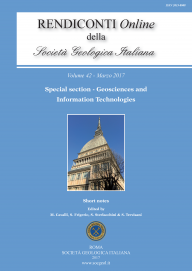
Using well log data and statistical Gaussian simulations to estimate the crack density value within a geothermal reservoir located in hard rocks
Mattia Aleardi
Department of Earth Sciences, University of Pisa, via S. Maria 53, 56126, Pisa (Italy). corresponding author e-mail: mattia.aleardi@unipi.it.
DOI: https://doi.org/10.3301/ROL.2017.24
Volume: 42/2017
Pages: 99-102
Abstract
To identify the most promising targets when exploring geothermal reservoirs it is crucial to infer the crack density value (the fracture density per volume) in the subsurface. In this work a geophysical forward modeling approach and statistical techniques were used to estimate the crack density within the deepest geothermal reservoir of the Larderello-Travale field where fractured intrusive/metamorphic rocks constitute the main drilling targets of geothermal exploration.
Waveform sonic recording and circumferential borehole imager log, acquired in the investigated area, evidenced the presence of several vertically aligned fractures with a preferential orientation NNW-SSE at the depth of the productive levels, whereas the encasing rocks appeared to be quite isotropic. This characteristic permitted to approximate the target level as a transverse isotropic medium with a horizontal axis of symmetry (HTI medium). Then, basing on borehole data, several models were developed that keep the encasing medium and the strike of the fractures within the target constant, but change the crack density from 0 (no fractures) to 0.1 (highly fractured). For each given crack density value, the associated P-wave and S-wave velocity values within the fractured zone were derived. Then, comparing the probability distribution of the simulated velocities with the logged velocities it was possible to estimate the most likely crack density value.
The proposed methodology applied to two wells returned plausible and similar results for the crack density value.
Keywords
Get Full Text